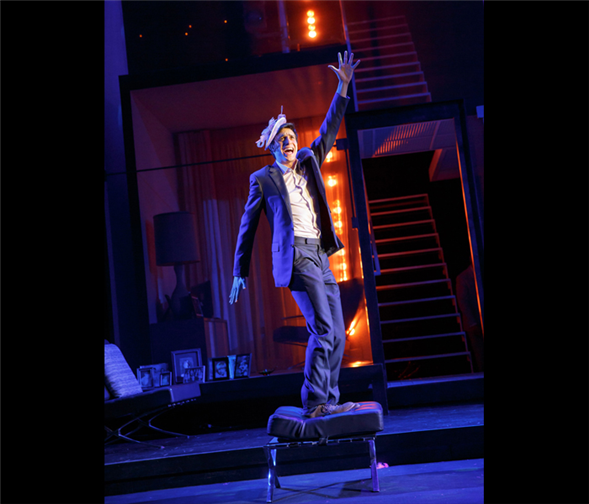Translate Page

Inside Significant Other's wedding choreography
---
You wouldn't think a goofy wedding dance could break your heart, but here we are. Early in Significant Other, which is now on Broadway at the Booth Theatre, three college friends are gathered for another friend's wedding, and at first, they're far too cool for this particular school. Hanging on the edge of the action, they joke about everything from the bridesmaid dresses to the groom.
Then the DJ plays "I Hope You Dance," that cheesy Lee Ann Womack ballad we've all heard in Walgreens, and though they start by mocking the song, they eventually start dancing. And then they get over themselves. They act out lyrics, take ridiculous leaps, and hurl each other around. More than anything, they burst with joy. We can tell how comfortable they are together, how they help each other feel free.
We also know this might be their last hurrah. After all, their fourth friend, the one who's getting married, isn't dancing with them. She can't. Her life has pulled her somewhere else.
Joshua Harmon's play, which appeared at Roundabout in 2015 before moving to Broadway, is about these simultaneous endings and beginnings. "It's about understanding the colossal, tragic, beautiful event of being best friends and then realizing that it's temporary and that you're only young for a very limited amount of time and everything is constantly changing," says Sam Pinkleton. "And for me, I was wondering, 'How do you [communicate] that without text?"
He had to ask that question, of course. He's the play's choreographer.
First and foremost, Pinkleton knew that honoring the story meant avoiding "sophisticated" choreography. "The point of Significant Other is not at all to make spectacular dance," he says. "It's about the moment when the night turns a certain way, when you've had the right amount of rosé, when you're feeling honest with your friends. You can reveal yourself in nerdy and truthful ways that you could not do with words. And that's the only thing I care about with this: It's a willingness to let yourself look like a fool and to express something without self-judgment."
To get the cast to that free-and-easy place, Pinkleton had them run through a particular game in rehearsals: He would throw out prompts – fake ballet! Britney Spears video! – and have them copy each other's moves.
If you think about, he says, that's the game we're all playing when we dance at weddings. "People who are not conditioned to be dancers are looking for an idea somewhere else," he explains. "If you're on the dance floor, you want to pick up somebody's move, or you want to throw in your own move for somebody else to pick up. We're all copying each other, and that creates community on the dance floor."
To that end, he didn't want the actors to worry about looking silly. "The thing we kept talking about was, 'As these ideas come to you when you're dancing, you have to believe that they're the greatest dance moves ever and no one has ever looked better doing them than you do.' It's the non-vomitus version of 'dance like nobody's watching.'"
{Image1}
And here's a secret: Pinkleton wants all of his work to feel this way, even when he's choreographing a more traditional musical. This spring, he'll have three productions running on Broadway at once -- Significant Other, the new musical Amelie, and Natasha, Pierre, and the Great Comet of 1812 -- and in each case, he wants the dancing to seem "real."
"My job is to put human beings on stage as themselves," he says. "In a way that's like, 'I'm a person with all of my weird tics and strange body things.' The thing I'm interested in, and that I'm decent at executing, is, 'What if we meet them as themselves?'"
He continues, "If everybody's coming at dance in their own way, then what becomes unexpected about it is, 'Oh god, I never thought that person would move that way, and they did this crazy thing.' My favorite dancers in Great Comet are the guys with bellies and mustaches, and they're the ones I make do the craziest shit. Because at first glance, you're like, 'Oh, that looks like my cousin Ted.' And then he's standing on his head. And to me, that has a little electricity in it that you don't have when somebody walks on stage presenting, 'I am a dancer, and I came here to do magnificent things.'"
Which isn't to say Pinkleton scoffs at highly trained dancers executing remarkable choreography. "I will never forget watching the end of Act I of Anything Goes and weeping uncontrollably as these people were moving like machines," he says. "It was so beautiful and mathematical, but I actually don't have the skills to do that. I would get cut in the first round of a Kinky Boots dance call."
Besides, he finds plenty of meaning in how everyday people cut a rug. "It's one of the most basic things that choreography can do," he says. "It's not about flashy-flashy. It's about, 'Oh, this incredibly confusing and chaotic world that we live in, that makes us deeply sad every day, suddenly has order.' Sometimes having three old ladies and a child standing in a line, moving their elbow at the same time, will be as dazzling as having 36 Broadway dancers in tap shoes doing 'I Got Rhythm.'"
---
TDF MEMBERS: At press time, discount tickets were available for 'Significant Other.' Go here to browse our current offers.
Follow TDF Stages editor Mark Blankenship at @IAmBlankenship. Follow TDF at @TDFNYC.
Photos by Joan Marcus. Top photo: Gideon Glick.